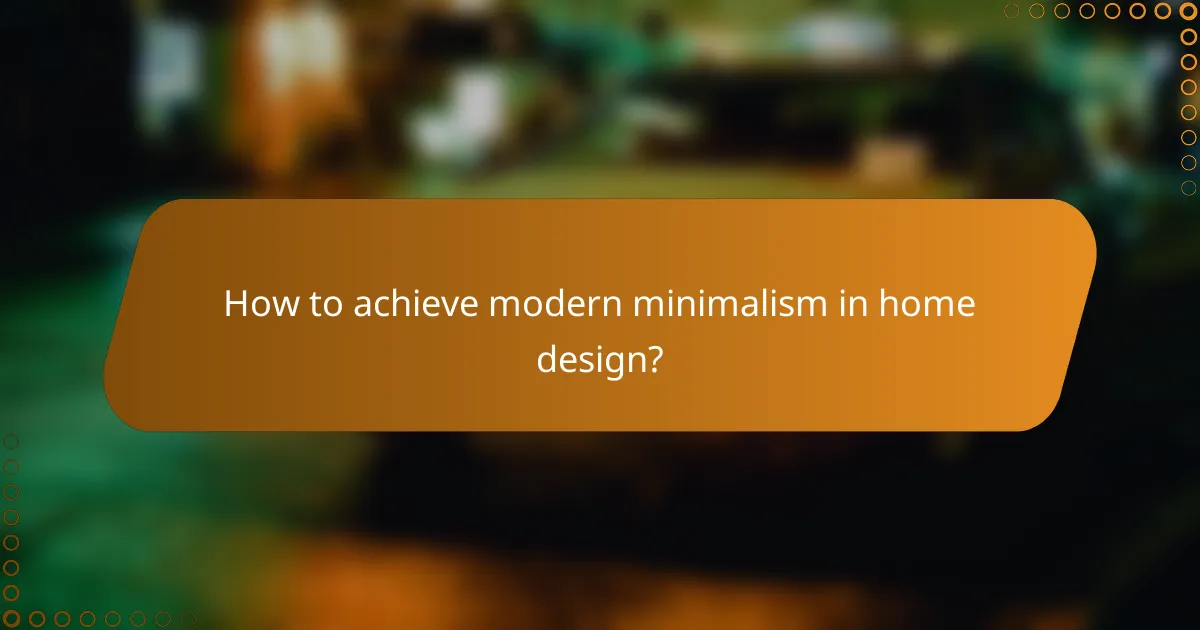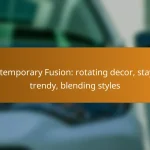Modern minimalism in home design embraces simplicity and functionality, creating serene environments through the use of sleek lines and neutral color palettes. By prioritizing open spaces, this aesthetic fosters a sense of calm and order, making it a popular choice for contemporary living. Whether through furniture or decor, the principles of modern minimalism invite tranquility into everyday life.

How to achieve modern minimalism in home design?
To achieve modern minimalism in home design, focus on simplicity, functionality, and a clean aesthetic. This approach emphasizes the use of sleek lines, neutral colors, and open spaces to create a serene environment.
Incorporate sleek furniture
Sleek furniture is a hallmark of modern minimalism, characterized by clean lines and a streamlined appearance. Opt for pieces made from materials like metal, glass, or light wood that enhance the open feel of a space.
When selecting furniture, consider multifunctional items that serve more than one purpose, such as a coffee table with storage or a sofa bed. This not only saves space but also maintains the uncluttered look essential to minimalism.
Use neutral color palettes
Neutral color palettes are crucial in modern minimalism, as they create a calm and cohesive atmosphere. Shades of white, beige, gray, and soft pastels work well together and can make a room feel larger and more inviting.
To add depth, consider layering different textures within the same color family. For example, pair a soft beige sofa with a wool throw and a silk cushion to create visual interest without overwhelming the space.
Maximize open space
Maximizing open space is essential for achieving a minimalist design. This involves decluttering and arranging furniture to allow for easy movement and flow throughout the room.
Consider using fewer, larger pieces rather than many small items. This approach not only enhances the sense of space but also simplifies cleaning and maintenance, contributing to a more serene environment.
Emphasize natural light
Natural light plays a vital role in modern minimalism, as it enhances the feeling of openness and connection to the outdoors. Use large windows, glass doors, or skylights to invite as much light as possible into your home.
To maintain privacy while still allowing light in, consider sheer curtains or blinds that can be adjusted. This balance helps to create a bright, airy atmosphere without sacrificing comfort.
Choose functional decor
In modern minimalism, decor should be both aesthetically pleasing and functional. Select items that serve a purpose, such as stylish storage solutions or art that also provides utility.
Avoid excessive decorative items that can clutter the space. Instead, choose a few statement pieces that reflect your style while maintaining the minimalist ethos. This could include a large piece of art or a unique sculpture that draws the eye without overwhelming the room.

What are the key characteristics of modern minimalism?
Modern minimalism is defined by its emphasis on simplicity, functionality, and a clean aesthetic. Key characteristics include sleek lines, neutral color palettes, and open spaces that promote a sense of calm and order.
Simplicity in design
Simplicity in design is at the heart of modern minimalism. This approach favors uncluttered spaces with a focus on essential elements, eliminating unnecessary decorations and distractions. The result is an environment that feels both spacious and inviting.
To achieve simplicity, consider using a limited color palette, typically featuring whites, grays, and earth tones. Furniture and decor should have clean lines and minimal ornamentation, allowing each piece to stand out without overwhelming the space.
Focus on functionality
Modern minimalism prioritizes functionality, ensuring that every item serves a purpose. This means selecting furniture and decor that not only look good but also enhance the usability of the space. Multi-functional pieces, such as a sofa bed or a coffee table with storage, are ideal.
When designing a minimalist space, think about how each element contributes to daily life. Avoid items that are purely decorative or that do not serve a clear function, as they can create clutter and detract from the minimalist aesthetic.
Use of geometric shapes
The use of geometric shapes is a hallmark of modern minimalism, contributing to the overall clean and structured look. Straight lines, squares, and rectangles dominate the design, creating a sense of order and balance. This can be seen in furniture, architectural elements, and decor.
Incorporating geometric shapes can be as simple as choosing a rectangular dining table or a square coffee table. Additionally, artwork featuring geometric patterns can enhance the minimalist theme without adding visual clutter.

Which brands offer modern minimalist furniture?
Several brands are well-known for their modern minimalist furniture, characterized by sleek lines, neutral colors, and open spaces. IKEA, Muji, and West Elm are among the top choices, each offering unique styles and price points that cater to minimalist aesthetics.
IKEA
IKEA is a global leader in affordable modern minimalist furniture, known for its functional designs and clean lines. Their products often feature neutral colors and modular components, making it easy to create open and airy spaces.
When shopping at IKEA, consider the practicality of their ready-to-assemble items. This can save money, but be prepared for some assembly time. Popular minimalist pieces include the MALM series for bedrooms and the LACK coffee table.
Muji
Muji emphasizes simplicity and functionality in its furniture, aligning perfectly with modern minimalist principles. Their designs often incorporate natural materials and a neutral color palette, which can enhance a serene atmosphere in any room.
Muji’s offerings include multi-functional furniture, such as storage solutions that blend seamlessly into living spaces. Their minimalist aesthetic encourages decluttering, making it easier to maintain an open environment.
West Elm
West Elm focuses on modern design with a commitment to sustainability, offering a range of minimalist furniture that combines style with eco-friendly practices. Their pieces often feature organic shapes and materials, suitable for contemporary homes.
When exploring West Elm, look for their curated collections that highlight clean lines and neutral tones. Items like the Mid-Century Modern sofa or the Industrial Storage Coffee Table exemplify their approach to minimalist living.

How to select the right color scheme for minimalist spaces?
Selecting the right color scheme for minimalist spaces involves focusing on soft, neutral tones that create a calm and spacious environment. The goal is to enhance the simplicity and functionality of the space while maintaining an inviting atmosphere.
Choose soft neutrals
Soft neutrals, such as beige, taupe, and light gray, serve as the foundation for minimalist design. These colors promote a sense of tranquility and allow other design elements to stand out without overwhelming the space.
When selecting soft neutrals, consider the lighting in your space. Natural light can change how colors appear, so test samples on walls at different times of day. Aim for a palette that complements your furnishings and enhances the overall aesthetic.
Incorporate monochromatic tones
Monochromatic tones involve using variations of a single color, which can add depth while maintaining a cohesive look. This technique works particularly well in minimalist spaces, as it emphasizes simplicity and elegance.
To effectively incorporate monochromatic tones, choose a base color and select shades and tints that range from light to dark. For example, a palette of soft blues can include sky blue, powder blue, and navy. This approach creates visual interest without cluttering the space.

What are the benefits of modern minimalism?
Modern minimalism offers numerous benefits, including a calming aesthetic, enhanced organization, and improved functionality. By focusing on sleek lines, neutral colors, and open spaces, this design philosophy creates environments that promote clarity and efficiency.
Enhanced tranquility
One of the primary benefits of modern minimalism is enhanced tranquility. The use of neutral colors and uncluttered spaces fosters a serene atmosphere, reducing visual noise and promoting relaxation. This calming effect can be particularly beneficial in homes or workspaces where stress levels are high.
To achieve tranquility, consider using a limited color palette, incorporating natural materials, and minimizing decorative items. Aim for a balance that feels open yet inviting, allowing for a peaceful retreat from the chaos of daily life.
Improved organization
Modern minimalism encourages improved organization by promoting a “less is more” approach. With fewer items in a space, it becomes easier to maintain order and find what you need. This streamlined approach can lead to increased productivity and reduced distractions.
To enhance organization, regularly assess your belongings and remove items that no longer serve a purpose. Utilize smart storage solutions, such as hidden compartments or multi-functional furniture, to keep spaces tidy while maintaining a minimalist aesthetic.
Increased functionality
Another significant advantage of modern minimalism is increased functionality. By prioritizing essential items and eliminating excess, spaces can be designed for optimal use. This focus on utility ensures that every piece serves a purpose, enhancing the overall efficiency of the environment.
When designing a minimalist space, consider the layout and flow of movement. Choose furniture that is not only aesthetically pleasing but also practical, such as a sleek sofa that doubles as storage. This approach maximizes space and ensures that each area is utilized effectively.










